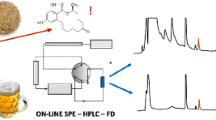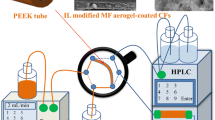Abstract
A new fast and sensitive method based on on-line solid-phase extraction on a fused-core precolumn coupled to liquid chromatography with fluorescence detection has been developed for ochratoxin A (OTA) and citrinin (CIT) determination in lager beer samples. Direct injection of 100 μL filtered beer samples into an on-line SPE–HPLC system enabled fast and effective sample extraction including separation in less than 6 min. Preconcentration of OTA and CIT from beer samples was performed on an Ascentis Express RP C18 guard column (5 × 4.6 mm), particle size 2.7 μm, with a mobile phase of methanol/0.5 % aqueous acetic acid pH 2.8 (30:70, v/v) at a flow rate of 2.0 mL min−1. The flow switch from extraction column to analytical column in back-flush mode was set at 2.0 min and the separation was performed on the fused-core column Ascentis Express Phenyl-Hexyl (100 × 4.6 mm), particle size 2.7 μm, with a mobile phase acetonitrile/0.5 % aqueous acetic acid pH 2.8 in a gradient elution at a flow rate of 1.0 mL min−1 and temperature of 50 °C. Fluorescence excitation/emission detection wavelengths were set at 335/497 nm. The accuracy of the method, defined as the mean recoveries of OTA and CIT from light and dark beer samples, was in the range 98.3–102.1 %. The method showed high sensitivity owing to on-line preconcentration; LOQ values were found to be 10 and 20 ng L−1 for OTA and CIT, respectively. The found values of OTA and CIT in all tested light, dark and wheat beer samples were significantly below the maximum tolerable limits (3.0 μg kg−1 for OTA and 2000 μg kg−1 for CIT) set by the European Union.

The beer contamination - potential sources of mycotoxins





Similar content being viewed by others
References
Xu B, Jia X, Gu L, Sung C. Review on the qualitative and quantitative analysis of the mycotoxin citrinin. Food Control. 2006;17:271–85.
Turner NW, Subrahmanyam S, Pilatesky SA. Analytical methods for determination of mycotoxins: a review. Anal Chim Acta. 2009;632:168–80.
Mikulíková R, Běláková S, Benešová K, Svoboda Z. Study of ochratoxin A content in South Moravian and foreign wines by the UPLC method with fluorescence detection. Food Chem. 2012;133:55–9.
Mateo R, Medina Á, Mateo EM, Mateo F, Jimenéz M. An overview of ochratoxin A in beer and wine. Int J Food Microbiol. 2007;119:79–83.
Ringot D, Chango A, Schneider YJ, Larondelle Y. Toxicokinetics and toxicodynamics of ochratoxin A, an update. Chem Biol Interact. 2006;159:18–46.
Běláková S, Benešová K, Mikulíková R, Svoboda Z. Determination of ochratoxin A in brewing materials and beer by ultra performance liquid chromatography with fluorescence detection. Food Chem. 2011;126:321–5.
Klarić MF, Rašić D, Peraica M. Deleterious effects of mycotoxin combinations involving ochratoxin A. Toxins. 2013;5:1965–87.
Peraica M, Domijan AM, Miletić-Medved M, Fuchs R. The involvement of mycotoxins in the development of endemic nephropathy. Wien Klin Wochenschr. 2008;120:402–7.
Ostrý V, Malíř F, Ruprich J. Producers and important dietary sources of ochratoxin A and citrinin. Toxins. 2013;5:1574–86.
Flajs D, Peraica M. Toxicological properties of citrinin. Arch Ind Hyg Toxicol. 2009;60:457–67.
EU. Commission Regulation (EC) No 1881/2006 of 19 December 2006 setting maximum levels for certain contaminants in foodstuffs. Off J Eur Union L. 2006;364:16.
EU. Commission Regulation (EU) No 212/2014 of 6 March 2014 amending Regulation (EC) No 1881/2006 as regards maximum levels of the contaminant citrinin in food supplements based on rice fermented with red yeast Monascus purpureus. Off J Eur Union L. 2014;67:4.
Odhav B, Naicker V. Mycotoxins in South African traditionally brewed beers. Food Addit Contam. 2002;19:55–61.
Trivedi AB, Hirota M, Doi E, Kitabatake N. Formation of a new toxic compound, citrinin H1, from citrinin on mild heating in water. J Chem Soc Perkin Trans. 1993;1:2167–71.
Tessini C, Mardones C, Baer D, Vega M, Herlitz E, Saelzer R, et al. Alternatives for sample pre-treatment and HPLC determination of ochratoxin A in red wine using fluorescence detection. Anal Chim Acta. 2010;660:119–26.
Mao J, Lei S, Yang X, Xiao D. Quantification of ochratoxin A in red wines by conventional HPLC–FLD using a column packed with core–shell particles. Food Control. 2013;32:505–11.
Cao J, Zhou S, Kong W, Yang M, Wan L, Yang S. Molecularly imprinted polymer-based solid phase clean-up for analysis of ochratoxin A in ginger and LC–MS/MS confirmation. Food Control. 2013;33:337–43.
Duarte SC, Lino CM, Pena A. Novel IAC-LC–ESI-MS2 analytical set-up for ochratoxin A determination in pork. Food Chem. 2013;138:1055–61.
Wang L, Wang Z, Gao W, Chen J, Yang M, Kuang Y, et al. Simultaneous determination of aflatoxin B1 and ochratoxin A in licorice roots and fritillary bulbs by solid-phase extraction coupled with high-performance liquid chromatography–tandem mass spectrometry. Food Chem. 2013;138:1048–54.
Huang LC, Zheng N, Zheng BQ, Wen F, Cheng JB, Han RW, et al. Simultaneous determination of aflatoxin M1, ochratoxin A, zearalenone and α-zearalenol in milk by UHPLC–MS/MS. Food Chem. 2014;146:242–9.
Arroyo-Manzanares N, Huertas-Pérez JF, Gámiz-Gracia L, García-Campaña AM. A new approach in sample treatment combined with UHPLC–MS/MS for the determination of multiclass mycotoxins in edible nuts and seeds. Talanta. 2013;115:61–7.
Llorent-Martínez EJ, Ortega-Barrales P, Fernández-de Córdova ML, Ruiz-Medina A. Quantitation of ochratoxin a in cereals and feedstuff using sequential injection analysis with luminescence detection. Food Control. 2013;30:379–85.
González-Peñas E, Leache C, López de Cerain A, Lizarraga E. Comparison between capillary electrophoresis and HPLC-FL for ochratoxin A quantification in wine. Food Chem. 2006;97:349–54.
Arroyo-Manzanares N, Gámiz-Gracia L, García-Campaña AM. Determination of ochratoxin A in wines by capillary liquid chromatography with laser induced fluorescence detection using dispersive liquid–liquid microextraction. Food Chem. 2012;135:368–72.
Dohnal V, Dvořák V, Malíř F, Ostrý V, Roubal T. A comparison of ELISA and HPLC methods for determination of ochratoxin A in human blood serum in the Czech Republic. Food Chem Toxicol. 2013;62:427–31.
Flajs D, Domijan AM, Ivić D, Cvjetković B, Peraica M. ELISA and HPLC analysis of ochratoxin A in red wines of Croatia. Food Control. 2009;20:590–2.
O'Mahony J, Clarke L, Whelan M, Kennedy R, Lehotay SJ, Danaher M. The use of ultra-high pressure liquid chromatography with tandem mass spectrometric detection in the analysis of agrochemical residues and mycotoxins in food - challenges and applications. J Chromatogr A. 2013;1292:83–95.
Köppen R, Koch M, Siegel D, Merkel S, Maul R, Nehls I. Determination of mycotoxins in foods: current state of analytical methods and limitations. Appl Microbiol Biotechnol. 2010;86:1595–612.
Songsermsakul P, Rizzazi-Fazeli E. A review of recent trends in applications of liquid chromatography-mass spectrometry for determination of mycotoxins. J Liq Chromatogr Relat Technol. 2008;31:1641–86.
Cigić IK, Prosen H. An overview of conventional and emerging analytical methods for the determination of mycotoxins. Int J Mol Sci. 2009;10:62–115.
Reiter E, Zentek J, Razzazi E. Review on sample preparation strategies and methods used for the analysis of aflatoxins in food and feed. Mol Nutr Food Res. 2009;53:508–24.
Vazquez BI, Fente C, Franco C, Cepeda A, Prognon P, Mahuzier G. Simultaneous high-performance liquid chromatographic determination of ochratoxin A and citrinin in cheese by time-resolved luminescence using terbium. J Chromatogr, A. 1996;727:185–93.
Franco CM, Fente CA, Vazquez B, Cepeda A, Lallaoui L, Prognon P, et al. Simple and sensitive high-performance liquid chromatography-fluorescence method for the determination of citrinin application to the analysis of fungal cultures and cheese extracts. J Chromatogr, A. 1996;723:69–75.
Arévalo FJ, Granero AM, Raba HFJ, Zón MA. Citrinin determination in rice samples using micro fluidic electrochemical immunosensor. Talanta. 2011;83:966–73.
Li Y, Wu H, Guo L, Zheng Y, Guo Y. Microsphere-based flow cytometric immunoassay for the determination of citrinin in red yeast rice. Food Chem. 2012;134:2540–5.
Nigović B, Sertić M, Mornar A. Simultaneous determination of lovastatin and citrinin in red yeast rice supplements by micellar electrokinetic capillary chromatography. Food Chem. 2013;138:531–8.
Rogatsky E, Braaten K, Cruikshank G, Jayatillake H, Zheng BN, Stein DT. Flow inconsistency: the evil twin of column switching-hardware aspects. J Chromatogr, A. 2009;1216:7721–7.
Fernández-Ramos C, Šatínský D, Šmídová B, Solich P. Analysis of trace organic compounds in environmental, food and biological matrices using large-volume sample injection in column-switching liquid chromatography. Trend Anal Chem. 2014;62:69–85.
Anli E, Alkis İM. Ochratoxin A and brewing technology: a review. J Inst Brew. 2010;116:23–32.
Tölgyesi Á, Stroka J, Tamosiunas V, Zwickel T. Simultaneous analysis of Alternaria toxins and citrinin in tomato: an optimised method using liquid chromatography-tandem mass spectrometry. Food Add Contam Part A. 2015;32:1512–22.
Skrbić B, Koprivica S, Godula M. Validation of a method for determination of mycotoxins subjected to the EU regulations in spices: the UHPLC-HESI-MS/MS analysis of the crude extracts. Food Control. 2013;31:461–6.
Prelle A, Spadaro D, Garibaldi A, Gullino ML. Co-occurrence of aflatoxins and ochratoxin A in spices commercialized in Italy. Food Control. 2014;39:192–7.
EU. Commission Regulation (EU) No. 105/2010 of 5 February 2010 amending Regulation (EC) No. 1881/2006 setting maximum levels for certain contaminants in foodstuffs as regards ochratoxin A. Off J Eur Union L. 2010;35:8.
Škarková J, Ostrý V, Malíř F, Roubal T. Determination of ochratoxin A in food by high performance liquid chromatography. Anal Lett. 2013;46:1495–504.
Acknowledgements
The authors are grateful to the Charles University Grant Agency for grant GAUK no. 1316213. I. Lhotská would like to acknowledge financial support of the project of specific research, no. SVV 260 292. The work was co-financed by the project GAČR no. 15-10781S.
Author information
Authors and Affiliations
Corresponding author
Ethics declarations
Conflict of interest
The authors report no conflicts of interest in this work.
Rights and permissions
About this article
Cite this article
Lhotská, I., Šatínský, D., Havlíková, L. et al. A fully automated and fast method using direct sample injection combined with fused-core column on-line SPE–HPLC for determination of ochratoxin A and citrinin in lager beers. Anal Bioanal Chem 408, 3319–3329 (2016). https://doi.org/10.1007/s00216-016-9402-6
Received:
Revised:
Accepted:
Published:
Issue Date:
DOI: https://doi.org/10.1007/s00216-016-9402-6




